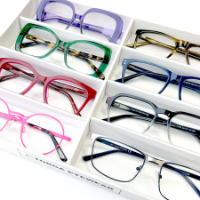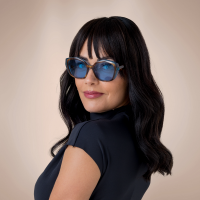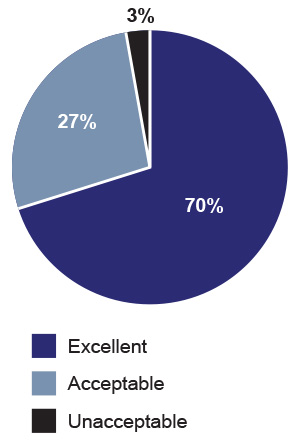Easivue Myopia
Management
World class Myopia management and control for your family
Is your child showing signs of near-sightedness or myopia?
Do they squint, blink excessively, or rub their eyes?
Do they complain of headaches?
Do they hold books and objects close to their face?
Do they sit closer to the television or at the front of the classroom to see?
Do they close one eye to read?
EVERYTHING YOU NEED TO KNOW ABOUT MYOPIA
Myopia, or near-sightedness, is a common vision condition where the shape of the eye causes that light that is entering it to refract incorrectly and focuses in front of the retina instead of directly on it. Or, in simple terms, it is when the eye grows too long, causing distant objects to appear unfocused and blurry, while close objects can be seen clearly.
Myopia currently affects approximately one in three people; however, the statistics are on the rise and indicate that by 2050, half the global population could be affected by myopia.
While it is a common refractive error in adults, the occurrence of myopia in children is becoming a growing concern worldwide. Although there may be many factors, it is thought that constant focusing on short distances by children – especially due to use of digital screens, reading, and other near work – while their eyes are still developing, is a major cause.
Progressive myopia, or early onset myopia, is near-sightedness in children that worsens rapidly year after year because the eye continues to grow longer than it should at each age stage. If not managed, it can develop into high myopia which is a severe form of near-sightedness. If left untreated, myopia can lead to lasting vision problems and other complications including myopic maculopathy, retinal detachment, glaucoma and cataracts.
Early diagnosis and management are essential for slowing the progress and avoiding high levels of myopia. Slowing myopia progression by just one diopter reduces the risk of developing myopic maculopathy by 40%!
Realising that your child’s eyesight may be deteriorating, can be worrying for any parent, but it can be managed, and your child’s visual health can be preserved now and in future.
Torga’s Easivue Myopia Management lenses are uniquely designed and internationally tried and tested, to address and slow the progression of myopia and improve vision at the same time.
Understanding the causes of myopia
Genetics
• Children of myopic parents are more likely to become near-sighted.
• One myopic parent doubles the risk for future myopia for children, while two myopic parents increase the risk by more than five times.
Visual habits
• Increased near work such as intense activity with digital devices or books is likely to contribute to the growing prevalence of myopia in children.
Environment
• Evidence suggests that a lack of natural light and not enough time outdoors may contribute to myopia progression. Between 80-120 mins outdoors is required daily
• Sleeping routines may also impact myopia development with a study showing that students who slept more than 9hrs were 41% less likely to have myopia compared to those who slept less than 5hrs.
Binocular vision
• Pre-myopes show a higher accommodative lag with the correlation becoming stronger after onset of myopia, indicating this may be a feature and cause of myopia.
What can be done?
Once myopia develops, early diagnosis and management are essential to slowing the progress to avoid high levels of myopia. Common management options for myopia include myopia control spectacle lenses, specialised contact lenses, medication (atropine drops) and even surgery, where appropriate.
When you visit Torga Optical, one of our optometrists will perform several visual tests with your child and screen for any retinal and corneal disorders. The results of the test and the prognosis for your child’s vision will be discussed with you to help you understanding the treatments recommended and how you can help keep your child’s vision clear and comfortable.
Why choose Torga Easivue lenses?
With the recent technological developments in myopia control spectacle lenses, these have, increasingly, become the preferred management option to slow myopia progression. Spectacles are also easy to adapt to, are well accepted and tolerated by children and are minimally invasive.
Torga Optical’s Easivue Myopia control lens is a spectacle lens that has been clinically shown to successfully slow the progression of myopia along with them being easy for kids to wear and look like regular glasses despite being a highly specialised lens. Easivue Myopia control lenses are completely transparent, like a normal single vision lens and the concentric circles are featured on the back surface as a freeform design. Other myopia control lenses feature concentric rings on the front of the lenses – which may make them look unattractive or unusual.
Easivue Myopia control lens has been specifically designed to fully correct the refractive error at the centre of the lens, with a myopic defocus in the peripheral area of the lens to assist in bringing the peripheral images of the retina to the front of the retinal plane.
Easivue Myopia control lens consist of a central vision area free of blur with stable refraction in a small area around the geometric centre, providing clear and sharpness central vision.
Proven European Clinical Trial Results
This was the first double-masked study done in European myopic children for testing a lens solution for myopia management.
This research tested though a prospective, controlled, randomized, double-masked clinical trial lead by the Universidad Europea de Madrid and following the recommendations of the International Myopia Institute.
The preliminary result of this clinical trial comprises a sample of 83 children divided in 2 groups:
• 42 children wearing single vision lenses and
• 41 children wearing Torga’s Easivue Myopia control lens during 12 months of follow-up.
12 Months Analysis
Results of the study showed that Torga’s Easivue Myopia control lens reduces myopia progression in comparison to the use of standard single vision lenses. Specifically, the growth of axial length was 39% smaller in the group wearing Easivue Myopia control lens than in the control group wearing standard single vision lenses after 12 months of follow-up.
97%
were satisfied with the performance of Easivue lenses at distance, intermediate, and near
95%
said Easivue lenses provided excellent comfort
100%
reported good sharpness while wearing Easivue lenses
Useful tips for parents
Adaptation period: The lenses require an adaptation period that varies from person to person (usually 1 to 3 days).
Activities during adaptation period: During this period, avoid driving any vehicle and engaging in active sports.
Long-Term wear: After adaptation, the patient should wear the glasses permanently (except during sleep and active/aggressive sports).
Checking position: Patient and parents should check the frame’s position daily to ensure proper fit.
Regular visits: Attend regular optometrist appointments (frame adjustments, prescription review, myopia progression monitoring, and treatment adjustments).
Environmental factors: Control environmental factors such as spending at least 2 hours outdoors, taking regular breaks for near tasks, using proper lighting and correct working distance, etc .

















